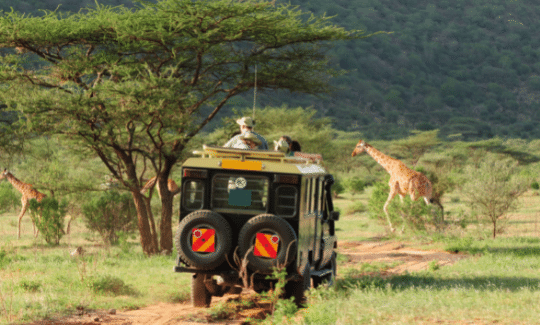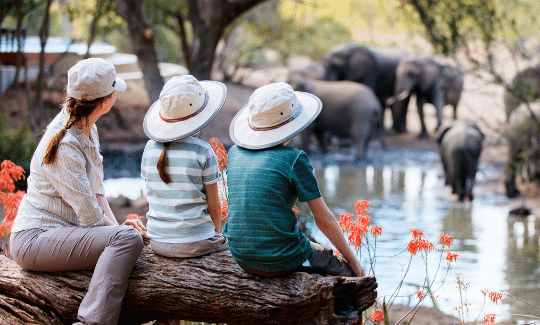Safari Tips: Fighting Heat and Dehydration
Safaris are an amazing way to immerse yourself into the wild African nature!
They get you up close with animals and environments that you would otherwise only be able to observe on television and, in some locations, they do all of this under some of the most brutal heat you’ll ever experience in your life.
Staying hydrated during your safari is extremely important, so here are a few tips to help you battle the heat and make sure you drink enough water!
#1 Cover your head and neck
While a simple baseball cap will protect your head and eyes from the sun, it will do nothing for you neck.
Try instead a wide-brimmed hat that will provide some shade to your neck, like a boonie or a fedora. If you can, go for textiles instead of leather, so that your hat is lighter and more breathable.
Another alternative is to wear a light cotton scarf, like a shemagh, to protect your neck from the sun. It can also come in useful to cover your mouth in dusty areas.
#2 Avoid excess alcohol and caffeine
Alcohol and caffeine are both diuretics, meaning they’ll cause you to have to pee more often.
Avoid large quantities of drinks containing them, such as wine and coffee, right before your game drives to avoid losing excess liquids.
#3 Bring a reusable water bottle
A reusable water bottle is a must when on safari!
Yes, the vehicle should normally be equipped with a water tank but, for convenience sake, it’s easier if you bring your own.
A large insulated bottle is ideal, as it will not overheat.
A normal steel or aluminium bottle will do the trick (I used a Sigg bottle on both my trips to South Africa), but don’t leave it in the sun or your water will be hot enough to shower with. Also avoid plastic bottles, they will degrade and leach chemicals into the water faster at high temperatures. It’s also unnecessary extra garbage.
#4 Don’t forget to drink often!
Drink small quantities of water at regular intervals, about every 10 to 15 minutes, instead of one large amount.
This way you’ll be sure to rehydrate regularly. If you have children, make sure they are also drinking enough and often.
#5 Don’t underestimate the sun
The Sun in certain parts of Africa can be deceiving, especially dry regions such as northern South Africa and Namibia.
Because of the lack of humidity you might not feel the heat as much, which can lull you into a false sense of security.
This type of heat is generally the most dangerous exactly for this reason. You might think everything is fine, while in the mean time you’re getting roasted, dehydrated and are at risk of heatstroke.
#6 Watch out for early symptoms
Be mindful of the first symptoms of dehydration and heat stroke:
Headache: A mild headache is often the first sign that you’re dehydrated. Never ignore it, notify your guide and drink plenty of water.
Confusion and disorientation: Confusion and disorientation are signs of severe dehydration or early heat stroke, so if you’re experiencing these symptoms be sure to get help.
Nausea: As with the previous, nausea is a severe symptom. It should never be taken lightly and needs to be dealt with immediately.
If you’re showing symptoms of severe dehydration or heat stroke, you should ideally get yourself out of the sun and drink small quantities of water mixed with sugar and salt. This will help you gain back the minerals you lost.
#7 Bring oral rehydration packets!
In case of severe dehydration, you might want to use an oral rehydration packet. This powder needs to be dissolved in water, and will help you regain lost minerals and fluids.
Remember that it is a type of medication and should only be used in cases where normal water is not doing the trick, for example if your headache is not passing.
Always be sure to follow the indications on the package and never exceed the recommended dosage!
Safaris are amazing opportunities to get close up and personal with incredible nature and wildlife, and in those moments it’s easy to get sidetracked and distracted.
𝘿𝙞𝙙 𝙮𝙤𝙪 𝙚𝙣𝙟𝙤𝙮 𝙩𝙝𝙞𝙨 𝙖𝙧𝙩𝙞𝙘𝙡𝙚 ?
𝘠𝘰𝘶 𝘤𝘢𝘯 𝘴𝘢𝘷𝘦 𝘰𝘳 𝘱𝘪𝘯 𝘵𝘩𝘪𝘴 𝘪𝘮𝘢𝘨𝘦 𝘴𝘰 𝘵𝘩𝘢𝘵 𝘺𝘰𝘶 𝘤𝘢𝘯 𝘢𝘭𝘸𝘢𝘺𝘴 𝘭𝘰𝘰𝘬 𝘣𝘢𝘤𝘬 𝘰𝘯 𝘵𝘩𝘪𝘴 𝘴𝘵𝘰𝘳𝘺 !
Always stay safe, remember to stay hydrated, take good care of your own health and your trip will be one the most memorable in your life!
I’ll see you on the trail and until next time this is Luca, signing off.












When it comes to experiencing the African nature up-close and personal, there is nothing better than a safari. That feeling of awe and wonder as you observe the continent’s fearsome wildlife in its natural environment is impossible to describe, and is something that needs to be experienced to be believed.